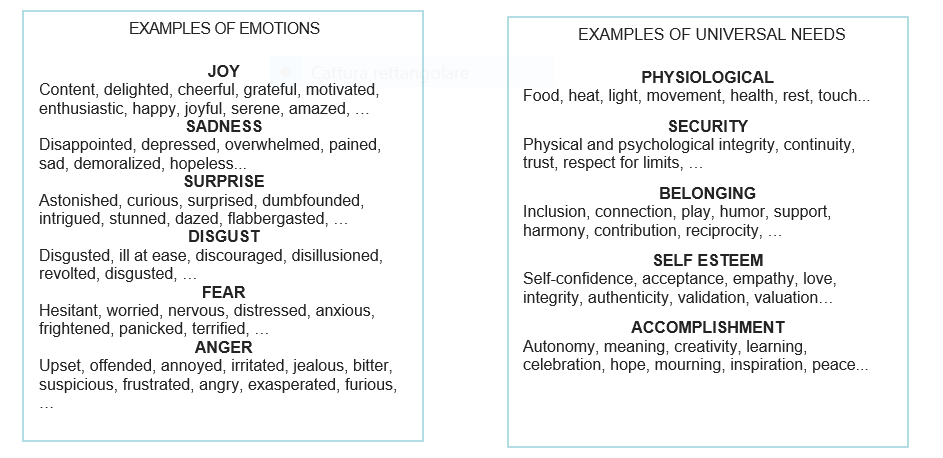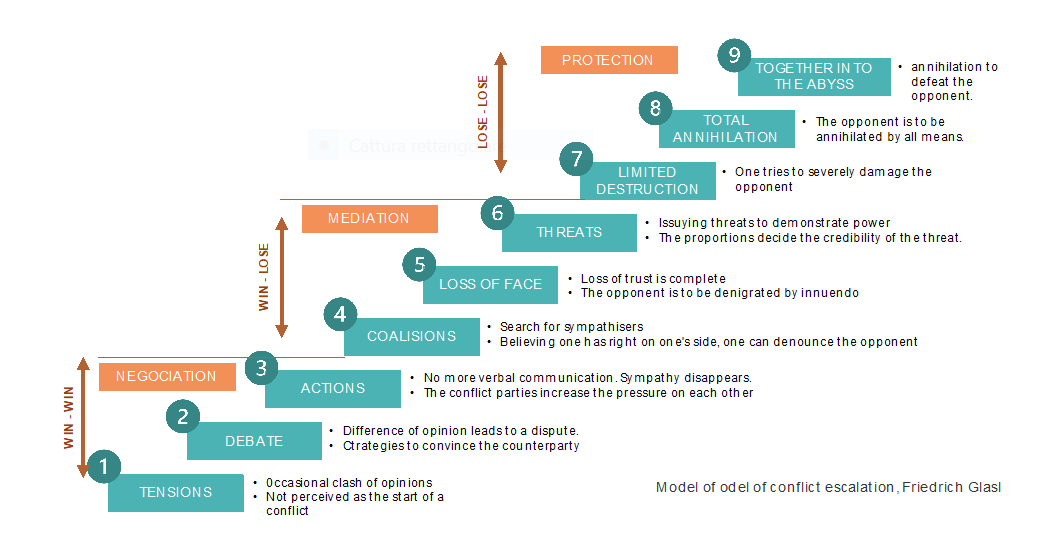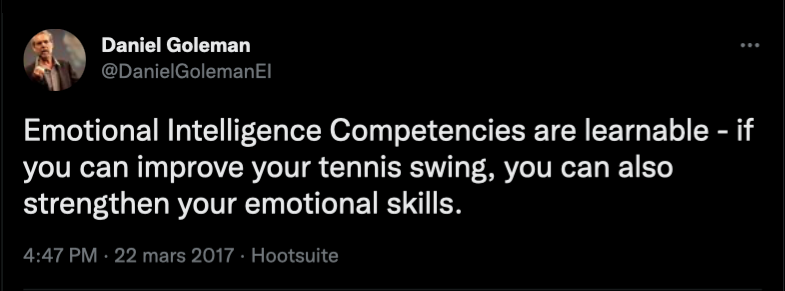Nonviolent Communication, a way to better understand each other, prevent conflicts, and strengthen resilience
When I first met Marshall Rosenberg in 2001, he helped me understood two keys that changed my life.
The first is that we are responsible for our own emotions and for how we react to circumstances. When we are happy, sad, or frustrated, what our interlocutor has said or done may be a stimulus to what we feel but it can never be the cause. As a consequence, we are not responsible for the emotions of others, and that is generally easier to conceive.
The second is that the emotions we feel are indicators of our basic human needs, as identified by Abraham Maslow. When our needs are satisfied, we feel a pleasant emotion, and when our needs are not satisfied, we feel a less pleasant emotion.
The Nonviolent Communication process developed by Marshall Rosenberg places the connection to universal human needs at the heart of the relationship to oneself and to others. Welcoming emotions is a starting point for connecting to our own needs and those of others, in authentic and kind relationships, to find mutually satisfactory solutions. Once all this is told, the hardest part is in practice.
Thoughts impact emotions
Emotion is an impermanent physiological reaction to an external stimulation. For example, imagine that you are in your car, looking for your way in an unfamiliar city. The driver of the car behind approaches his vehicle dangerously and honks his horn. A glance in your rear-view mirror reveals his scowling face and agitated gestures. You feel your heart beating faster, your hands getting sweaty and your jaws clenching, and you feel the urge to shout an insult at him to vent the tension generated by the adrenaline rush in your body. Fortunately, the driver in a hurry pulls out and makes his engine roar while overtaking you. After refocusing on your intention to arrive calmly at your appointment, you are able to come back to yourself and tell yourself that this person was certainly in a hurry. You open the window to breathe and lower your body temperature. Your heart rate slows down as you arrive at your appointment.
When an emotional state is further maintained by thoughts, internal discourse, even ruminations the emotion can transform into a lasting affective state. Let's imagine in the previous example that you entertain the thought that people from this foreign region really drive like crazy - take the episode you have just experienced as proof! Your brain, by association, brings back to your memory similar episodes of your life to confirm your opinion. Reinforced in your “legitimate indignation”, you are already preparing the story that you are going to tell your friends. Meanwhile, by entertaining negative thoughts, you keep the adrenaline and cortisol levels high in your blood. The tension in your body sets in, your jaws remain clenched, and you nervously close the door of your vehicle after having painfully parked.
Connect to underlying needs
According to Marshall Rosenberg, “At the heart of all anger is an unmet need. Anger can be very useful if we use it as a warning signal: it allows us to realize that there is an unmet need within us […]. Fully expressing our anger requires the ability to be fully aware of our needs. […] Instead of giving in to “legitimate indignation”, it is therefore better to consider with empathy our own needs and those of others. This certainly does not happen overnight, but it is achieved by systematically replacing the expression "I am angry because they..." by: "I am angry because I need ..." »
The fiction above illustrates well the two keys of NonViolent Communication. In this example, you are responsible for the emotional state maintained by your thoughts in either case, and you are not responsible for the emotional state of the driver behind. Indeed, in this situation, another driver could have shown more patience and kindness, which is perhaps what you needed.
In a situation like this, taking a few minutes to connect with your need for kindness and serenity could allow you to return to a calm emotional state, and to be fully available for your appointment.
The ability to recognize and manage one's emotions and needs is one of the pilar of emotional intelligence, described by Daniel Goleman in the late 90s. Today more than ever, these abilities are an integral part of the key skills of leaders.
In the boxes below are different examples of emotions and needs. How do you feel right now? What are the three most satisfied needs in your life? What are the three least satisfied needs?
BOX: Examples of emotions and needs from the categories of Paul Eckman (emotions) and Abraham Maslow (needs).

De-escalate conflict
Acknowledging emotions and needs is just as important in interpersonal relationships and within groups. When unacknowledged, emotions can intensify, polarize relationships, and generate a contagion within a collective, especially when they are linked to a need for security.
In the case of corporate restructuring for instance, an employees’ concern due to a need for clarity and visibility on their future can turn into anxiety and social climate disruption if no timely information is provided ; a doubt linked to a need for meaning can turn into distrust if the intention of the hierarchy is unclear and measures are not consistent with the discourse; frustration linked to a need for recognition can turn into resentment and anger if a situation perceived as unfair persists.
To establish or restore trust in a relationship, it is therefore important to acknowledge emotions when they emerge and to take the needs of the parties involved into account to seek mutually satisfactory solutions.
However, preventing or solving a dispute starts with us. Marshall Rosenberg affectionately called Jackal the part of us that makes judgments about ourselves or others. Behind each of our judgments, there is an unmet need. Welcoming one's own judgments with curiosity allows us to approach our needs with authenticity, and to open up to creativity to seek potential solutions.
Conversely, if we enter a conversation without having transformed our own judgments, these will bias our intervention. It is likely then that the other part will hear our judgments beyond our words and the relationship may be affected or become polarized around each other's positions.
The process of NonViolent Communication is instrumental in negotiation or mediation approaches to prevent or resolve a conflict in its early stages, according to the conflict escalation model developed by Friedrich Glasl, Austrian consultant and mediator.
BOX: Conflict escalation model according to Friedrich Glasl

Strenghten Resilience
Our ability to regulate our emotions and needs is also one of the pillars of our resilience and supports our discernment to make good decisions. Moreover, research in epigenetics has shown that the quality of our family, friendly and social relationships is one of the five areas that have a concrete impact on our health.
The good news is that, as Daniel Goleman puts it, emotional intelligence competencies are learnable with practice, like any other activity! It is therefore up to everyone to practice this relational hygiene to oneself and to others.

* Book reference: Nonviolent communication: A Language of Life, Marshall Rosenberg, Puddle Dancer Press, 2015.
Scritto da
Sylvie-Nuria Noguer
Sylvie-Nuria Noguer is a certified professional Coach, a mediator, a trainer, and an author. She has been trained in NVC both in Europe and in Québec for more than 20 years. Mechanical Engineer with a specialization in psychosociology, she is passionate about people. She works with leaders and their teams in their transformation and decision making to actualise their raison d'être. She is the author of Donnez du sens à vos decisions (Eyrolles, 2018), a book proposing an integral approach to strategical decision making in complex situations.




